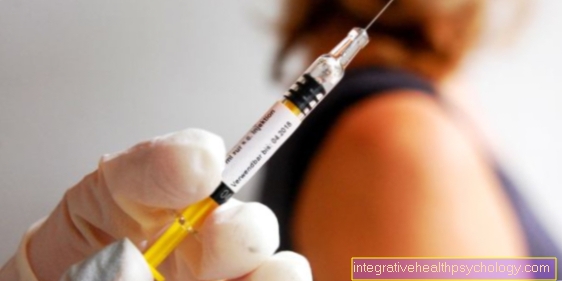Allergy diagnostics
introduction
In order to be able to diagnose an allergy, a doctor-patient consultation usually takes place first in order to find out more about the medical history and the situations in which symptoms occur.
In this way, the first connections can be recognized and specific allergy diagnostics can be carried out using allergy tests. Most allergy tests are based on triggering an immune reaction or detecting antibodies to a specific allergen in the blood. For this, the allergen should be known as possible or at least there should be a suspicion of this as a trigger.

What allergy tests are there?
In allergy tests, a distinction is made between skin tests and laboratory chemical methods.
The skin tests include the following:
- Rub test
- Prick test
- Scratch test
- Intracutaneous test
The tests differ in their invasiveness. In the rub test, the allergen (a substance that can cause an allergic reaction) is rubbed over the inside of the forearm. In the prick test, an allergenic liquid is applied to the forearm and the skin is pierced with a lancet. The scratch test differs from the prick test in that the skin is first scratched about 1cm and then the liquid is poured onto it. In the intracutaneous test, the test liquid is injected directly into the skin.
You can also examine the blood for certain defense proteins (antibodies, here specifically IgE), which are formed in an allergic reaction. However, this investigation is relatively unspecific. Furthermore, a RAST can be carried out, which can detect specific antibodies, but is very complex. It is also possible to determine the tryptase concentration in the blood. Elevated values can indicate particularly severe allergic reactions.
Also read our topic: Symptoms of an allergy
Prick test
The prick test is a standard in allergy diagnostics. This test uses an area of skin typically on the inside of the forearm. At the beginning of the test, a grid with numbering is drawn on the forearm. Then, according to the numbering, drops of different liquids are applied to the skin.
The standard includes a positive and a negative control as well as 15-20 test substances. The positive control contains histamine and always shows a skin reaction. The negative control is isotonic saline and should not cause skin reactions. The test substances contain the most common known allergens, i.e. substances to which humans can have an allergic reaction.
A lancet is used to pierce the skin through the drop. Through this small wound, the fluids get into the deeper layers of the skin.
If you have an allergic reaction to one of the test substances, the fluid is recognized by defense cells, the mast cells. These then release the tissue hormone histamine. Histamine causes the vessels to widen at the skin site. This leads to reddening of the skin. In addition, the vessels also become more permeable so that fluid can escape into the surrounding tissue. This fluid will then be noticed as a small swelling or wheal. Finally, even the smallest nerve endings are irritated by the skin reaction and the typical itching occurs.
Learn more about the Prick test
RAST
RAST stands for Radio-Allergo-Sorbent-Test. This test procedure can be used to assess whether there is an allergy to a specific allergen and how severe the allergy is.
In the classic method, cell components (antigens) of a certain allergic substance are first applied to a paper. You can examine substances one after the other to which many people are allergic or check whether a certain allergen is suspected.
Then you put some of the patient's blood on this paper. If an allergic reaction occurs, so-called antigen-antibody complexes are formed. The antibodies are produced by the defense cells in the blood and are defense proteins. They specifically bind to the antigens that were previously applied to the paper.
These antigen-antibody complexes can be made visible with a radioactive substance. The amount of radioactive radiation corresponds to the number of antibodies formed and so one can draw conclusions about the severity of the allergic reaction.
The result is given in RAST classes. 0 means no reaction against the antigen and 4 corresponds to a high dose of antibodies, i.e. a severe allergic reaction. Due to the complex process with radioactive radiation, the process is only rarely used.
You may also be interested in this topic: Testing for a food allergy
CAP test
As already mentioned, the RAST, Radio-Allergo-Sorbent-Test, is only rarely used.
Instead, the carrier polymer test (CAP test) has prevailed, in which immunoglobulin E antibodies are also measured, but instead of radioactive substances using enzymes or fluorescent substances. The CAP test also distinguishes between 7 different levels instead of 5, with a scale ranging from 0 to 6 with 6 being the strongest allergy.
What does an allergy diagnosis cost?
As a rule, allergy diagnostics are covered by all statutory and private health insurances.
The doctor must have a legitimate suspicion of a possible allergy in order for the diagnostic measures to be paid for by the health insurance company. If this is suspected, the skin tests as well as the testing of IgE or a provocation test can be submitted to the health insurance company.
You may also be interested in this topic: How can you test for histamine intolerance?





























